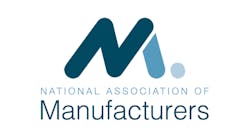Jay Timmons will be listening closely to tonight’s State of the Union address by President Barack Obama, but he says what the manufacturing community needs is action.
Timmons, NAM’s president since 2006, says manufacturers appreciate the president’s attention to the manufacturing sector. He says they agree with his calls for action on rebuilding the nation’s infrastructure and doubling exports by 2015. He says NAM has partnered with the administration on workforce issues and recognize that hundreds of thousands of manufacturing jobs go unfilled because workers lack the skills for these positions. And Timmons credits the president for understanding that the continued exploration and development of domestic natural gas supplies is important to the U.S. economy.
But Timmons also has a long list of issues for which more work is needed. Among them:
Taxes: The U.S. has the highest corporate tax rate in the world and “does not incent manufacturers to bring corporate profits back to the U.S.,” he says. Moreover, two-thirds of manufacturers pay taxes at individual rates. Tax reform that raises revenue, he says, simply shifts the burden and does nothing to make the country more competitive.
Regulations: EPA’s proposed regulations for greenhouse gases and ozone, says Timmons, will also hurt manufacturers’ competitiveness. He said EPA needs to have “robust” conversations with the business community to ensure that new regulations can be met and that they make sense economically.
Trade: Trade agreements need to be focused on expanding opportunities for U.S. manufacturers while protecting their intellectual property, Timmons says. He wants the administration to support bills in Congress providing the president with trade promotion authority, something he notes eveyr president since Franklin Roosevelt has had.
“The bottom line is that it is 20% more expensive to manufacture in the United States than anywhere else in the world,” noted Timmons, because of tax and regulatory policies.
In recent years, NAM could no longer count on the same level of support from Republicans that it had in the past. In particular, Tea Party Republicans have been reluctant to support some of the investments, such as in infrastructure, that NAM has advocated.
“When some folks came to Washington in 2010 and 2012, they came with an idea that everything in Washington was broken,” he observes. “Things that we have done as a nation to strengthen our economy over the years – not everything was headed down the wrong path. It does take additional effort to educate members on what makes the country competitive in a global economy.”
He recalled NAM’s tough fight to fund the Export-Import Bank and convince members that “it was not in our nation’s interest to unilaterally disarm the United States economically by defunding the Ex-Im Bank and Ex-Im’s ability to finance exports when other nations are not only financing exports but doing so more robustly than we do and much more aggressively.”
Asked whether NAM supports Obama’s effort to create a network of manufacturing innovation hubs around the country (the first two have been established in Youngstown, Ohio and Raleigh, N.C.), Timmons said his organization supports anything that “maintains our innovative edge.”
But Timmons said the nation also needed “a permanent and much more robust research and development tax credit.” He said the history of reauthorizing the tax credit retroactively or “annually in the best of cases” does not allow companies to properly plan for investments that can take years to bring to fruition.
Manufacturers Frustrated with Washington
While some manufacturers are unabashed in calling for the federal government to stay out of their business, Timmons said a partnership with government is necessary to compete successfully in the global economy.
“The bottom line is what you are hearing from folks is a frustration about Washington in general, with Washington not working,” Timmons posits. He refers, for example, to 2,300 regulations being imposed on manufacturers over the last 30 years. He says not all these regulations are bad but there is a limit to how many are needed to protect the health and safety of employees and the public.
Timmons does not look at U.S. manufacturing currently and see a renaissance – at least not yet.
“I think we are on the edge. When I talk to manufacturing leaders throughout the country, I sense this pent-up optimism," he says. "There is a desire to invest in our country. There is a desire to create more jobs here. Let’s be realistic. There were 2.5 million jobs lost during the Great Recession and we have only gained 500,000 of those back. We have a long way to go before we can cheer a full recovery of the manufacturing sector.”
Timmons says the U.S. is starting to see more investment in manufacturing. With the right policies and legislative action, he wrote in a January 26 article with Caterpillar CEO Doug Oberhelman, the U.S. could grow industrial production by 4.5% annually, grow the economy by at least 3% and create more than 20,000 manufacturing jobs a month.
“We need to get back to the basics,” he concludes. “We need to focus on a growth agenda.”



